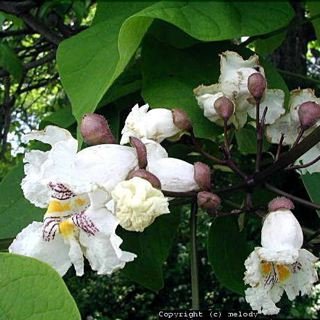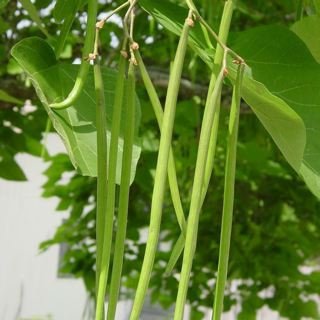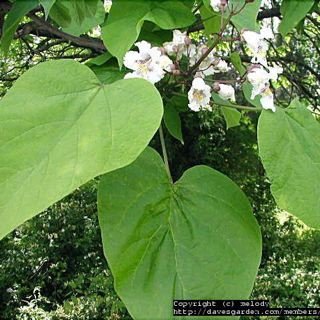





You either hate the catalpa or you love it, there is very little room for any other sentiment. No matter which side of the fence you lean toward, you might change your mind after reading this article.
As a student of the arts back in the '60s, I was required to take a class in 3-D art forms. That meant that I put away my canvas and brush and learned to whittle, carve, build, stack, hammer, saw, and climb. I was used to climbing mountains, so that part should have been easy. But no, climbing mountains and climbing around on scaffolding are two different things. Nothing in my life ever terrorized me as did that 3-D class. I passed it, but barely, with thanks to a chunk of catalpa wood.
The catalpa and I go way back. There were several catalpa trees growing along the north fork of the Kentucky River where I lived while growing up. A bunch of my friends and I used to picnic beneath one of them in the early summer months. It bloomed then, and those blossoms rivaled the most glorious orchid: large white blooms, that attracted so many bees you would have thought we would all be stung. But as I remember it, we must have had an agreement with the bees, because I don't think we ever had a single bee sting among the group of us. 
Catalpa bignonioides is a small deciduous tree that usually does not grow beyond a height of about 40 feet. It grows in rich moist soil beside streams and rivers. It is hardy to zone 5. It flowers from June to July, and its seeds ripen in October through December. It cannot grow in shade. It is also sometimes called the Catawba tree, the name derives from the Catawba Native American name for the tree. There is some thought that the name should at all times be catawba, and that during transcription or translation, the word was misspelled and resulted in the current name: Catalpa. We might never know, but for practical purposes, it is most often referred to as the catalpa.
There are two species in North America, the northern catalpa (Catalpa speciosa), which has larger leaves, flowers and bean pods; and the southern species which bears little difference except in size. They both bear large heart shaped 3 lobed leaves. The large size of the leaves provides a very dark shade and is a popular habitat for birds.
There was another interesting side of the catalpa tree that I was familiar with all those years ago; it was a good source for fishing worms. For the longest time, I thought the worms were just a part of the tree, and it never occurred to me that they didn't hatch right out of the leaves. Those folks who were lucky enough to live beside a stream or river were the ones who provided buckets of fishing worms for those who didn't, for a small price, of course. I remember one old guy who sat under his catalpa tree every day of the summer doing nothing more than picking worms right off his tree and selling them fresh to fishermen who came by. I thought that might be a good business for me to get into, but my mother told me that she wouldn't have a messy catalpa tree growing anywhere  near her house.
near her house.
And that is the downside of the catalpa. It is a mess. It sheds those large leaves, it drops large flower petals, it loses its large cigar shaped seed pods, and it is the food plant of the caterpillar of the Catalpa sphinx moth, the very popular fishing worm. If you prefer a picture perfect lawn, then the catalpa is not for you, because it truly rivals the magnolia for being the messiest tree in this country. But it also rivals the magnolia for its supreme beauty.
Over the years, the catalpa has served many medicinal purposes. At one time the Native Americans used it as an antidote for snake bites. The tea made from its bark acts as a sedative, and it also produces a mild narcotic reaction. At times the tea from the bark was also used as a substitute for quinine in treating malaria. Its seed tea was used to treat whooping cough as well as asthma and bronchitis. Its leaves were used as a poultice on wounds and abrasions.
The wood of the catalpa is also valued. It is lightweight and has a soft rich luster; its grain pattern flutters around with the light and when rubbed to a rich finish, it has the texture of pure silk. Its wood is also used for posts and fence rails, as well as interior finishes for cabinetry. The catalpa is a fast growing tree with an extensive root system, and it is a valuable tree when planted on land that is subject to landslides. It stabilizes the soil. It is often sought after to help prevent erosion, and to help reclaim land that has been mined.
It was this valuable wood that saved my college career. Now right up front I will tell you I breezed through college, and found myself in my senior year with a couple of useless degrees. Since I had to make a living some way, I decided to pick up enough classes so that I would be qualified to teach studio art, just in case nobody needed an art history or an ancient history/humanities major. With a couple of minors and a teaching certificate under my belt, I figured I had covered all bases. You see, when you are meeting the world head-on fresh out of the southern Appalachian mountains, you needed a pretty strong base to stand on. I had it all figured out, until I took that 3-D class, and met the scaffold face to face. I simply was too short to pole vault myself upon the scaffolding and had to have a ladder to get to the first level. We were learning to carve huge chunks of plaster, pretending to be Michelangelo, and no matter how much I really wanted to carve my own David, it wasn't to be. I was no good at carving. So I tried sculpting with clay, and that was a little better, but not great. I tried it all, and was obviously doomed for failure. Finally my patient professor asked m e if I thought I might be able to carve wood. I told him that I had whittled around on catalpa wood over the years, but hadn't made much of anything. He said: "YOU whittled on CATALPA WOOD? Where did you get CATALPA WOOD? Can you get some for ME?"
e if I thought I might be able to carve wood. I told him that I had whittled around on catalpa wood over the years, but hadn't made much of anything. He said: "YOU whittled on CATALPA WOOD? Where did you get CATALPA WOOD? Can you get some for ME?"
I passed that class, not with flying colors, but I did pass, but only after I made a fast trip home over the following weekend, and gathered up every large piece of catalpa branch that I could find. I finally made something that vaguely resembled a totem pole for my last project, and last I heard, my professor was still carving away on his numerous pieces of catalpa. Little did I know at the time that catalpa carvings are very beautiful and also very pricey. I have always wished my professor well, he sure was tolerant.
I learned a lot in the class, I learned that I should always stick to canvas and brushes and stay away from sculpting and carving.
Resource for verification: http://en.wikipedia.org/wiki/Catalpa
Photos are from Plant Files. Thanks to these photographers: Angele for the thumbnail, Melody for the second and fourth photos, and Htop for the third image.
(Editor's Note: This article was originally published on December 28, 2010. Your coments are welcome, but please be aware that authors of previously published articles may not be able to respond to your questions.)
Copyright © www.100flowers.win Botanic Garden All Rights Reserved